Remote Data Center Monitoring During Coronavirus

IT has dealt with viruses for decades, but not of the pandemic variety like coronavirus. Nearly all industries will be impacted by the virus’s spread and we need to be aware of the potential IT and related business issues that could arise.
Disruption to IT operations in data centers is inevitable. With travel restrictions escalating daily due to closed borders and shelter-in-place orders, last-mile IT field engineers may be prevented from accessing facilities where they have critical maintenance and repair responsibility. And even if they can get to a customer location, physical access to customer premises to resolve hardware faults – something as simple as switching out a drive in the data center – may be restricted as a result of quarantine.
Let’s step back and observe another potential source of disruption from another perspective. Field engineers who maintain data center hardware are dependent upon parts to resolve faults in IT infrastructures and systems. And although fans and power supplies typically are commonplace and inexpensive, these are not typical times. A part that normally is shipped the same day or overnight may now be subject to a timetable that accounts for coronavirus concerns if it’s shipped to or from areas where there is restricted movement. Both the manufacture and distribution of such parts are likely to be delayed, delaying the fix.
Minimizing Disruptions
Maintaining some semblance of regular operations requires steps to minimize these disruptions. Enterprises with IT good asset management control are better able to maintain stable IT operations. These organizations are armed with the knowledge of where all of their hardware assets are located in the world, especially in relation to restricted regions and activities, as well as the ability to detect faults that may occur during this global challenge.
In addition, automation, robotics and AI are increasingly prevalent in the digital age and organizations have adopted these advanced technologies to support their business and IT operations. The application of dynamic base lining is one example where organizations are realizing value from predictive analytics to proactively manage infrastructure. Another example is the integration of technologies like S.M.A.R.T. events, which generate alerts prior to actual failure. Organizations are applying remote automation and AI to help ensure that their IT infrastructures continue to operate, down to automated and proactive fault detection and resolution capabilities.
AI tools have the power to predict and self-learn through patterns, potentially helping alleviate IT issues and resolve faults quicker than through human interaction. In times like these, it’s not only faster, but possible, when human interaction is restricted.
With remote monitoring tools, companies can automate fault resolution processes for hardware infrastructures. Remote monitoring tools can initiate hardware service tickets with agents that poll systems remotely through standard protocols, such as SNMP, WMI and SSH, and then communicate hardware events back to the IT administrator through an outbound TCP connection. This process ensures IT operations (and businesses) continue despite quarantined areas, restricted business and limited staff.
In addition, effective IT customer service portals further enable enterprise customers to raise and monitor service tickets from any device, potentially getting their faults logged, tracked and resolved rapidly at a time when call centers and their staff may be overwhelmed.
Beyond customer service portals, mobile applications can place these capabilities in the palm of your hand. Mobile apps enable users to identify devices that need support by using the phone’s camera to scan the bar code. The application then decodes the bar code and automatically populates the corresponding serial number in a ticket submission form. Companies using mobile apps through traditional portals can elevate the convenience and efficiency of service and attention, all while finding a new way to stay connected.
Disruptions are inevitable during the current crisis. With a compromised workforce, multiple services and tools can alleviate the pressure on IT operations and bring peace of mind to businesses. Most critically, automation and remote monitoring can play a massive part in keeping IT services running smoothly so that businesses can maintain continuity and certainty in these very uncertain times.
Paul Mercina is director of product management at Park Place Technologies, a data center strategy and support services company.










